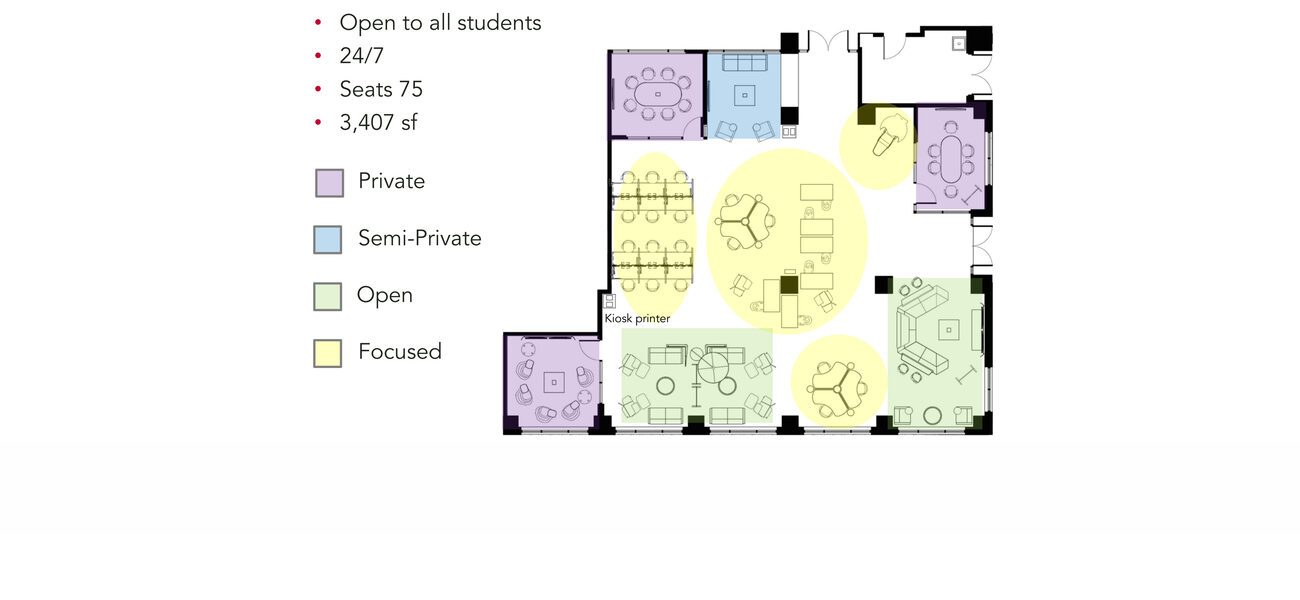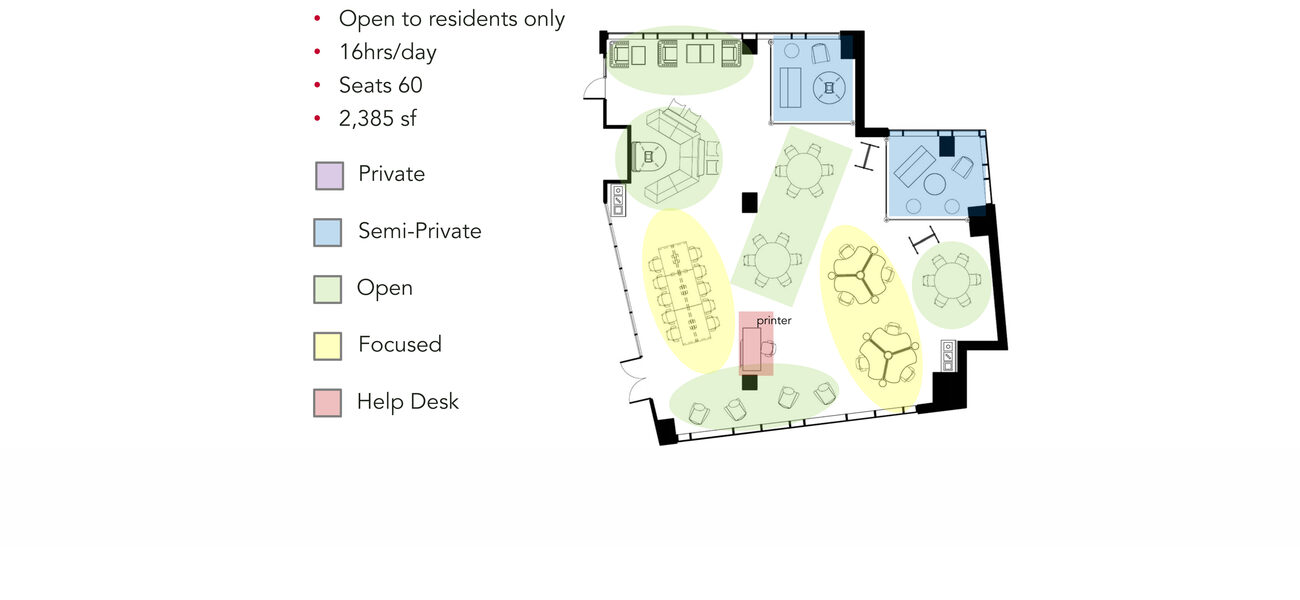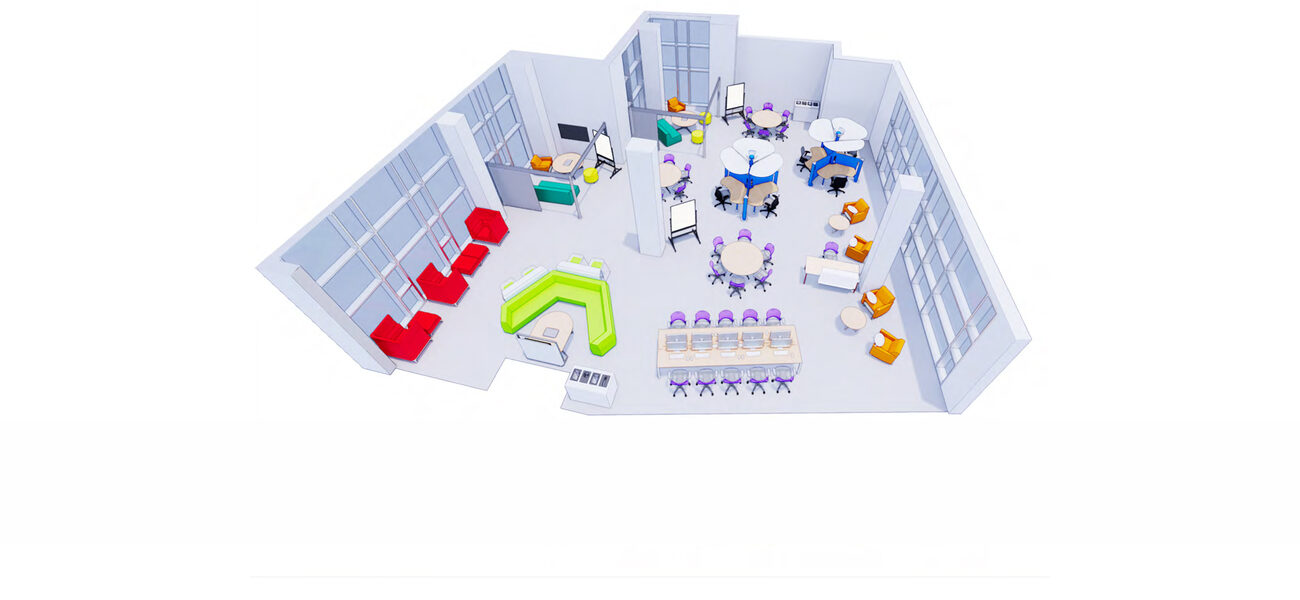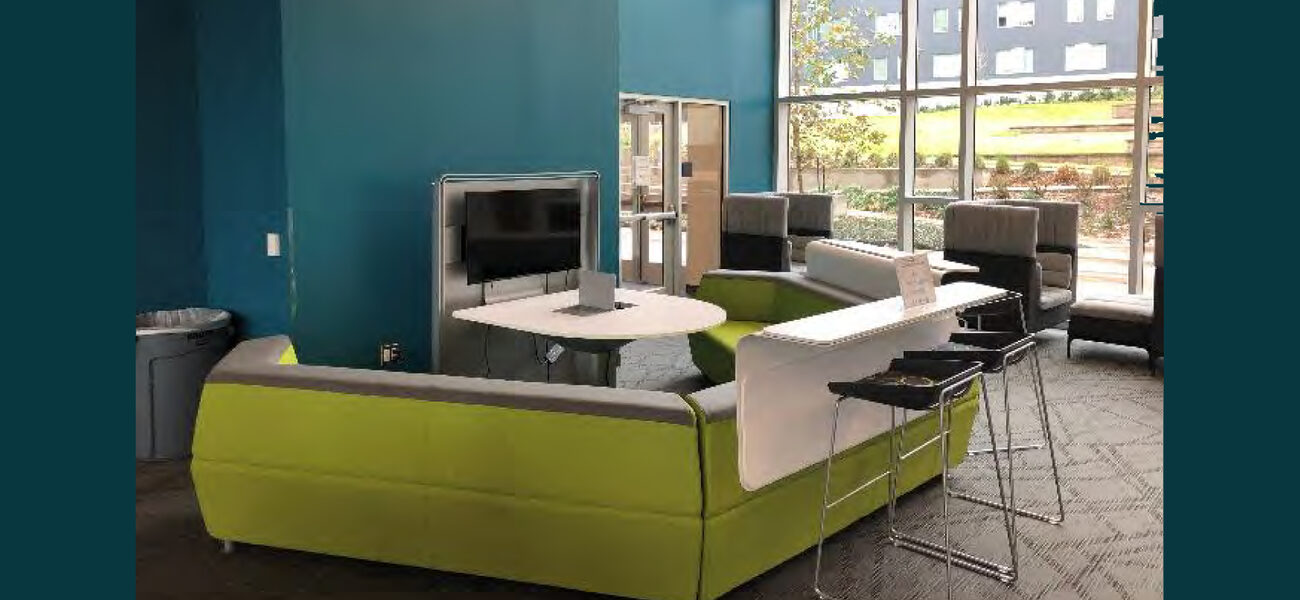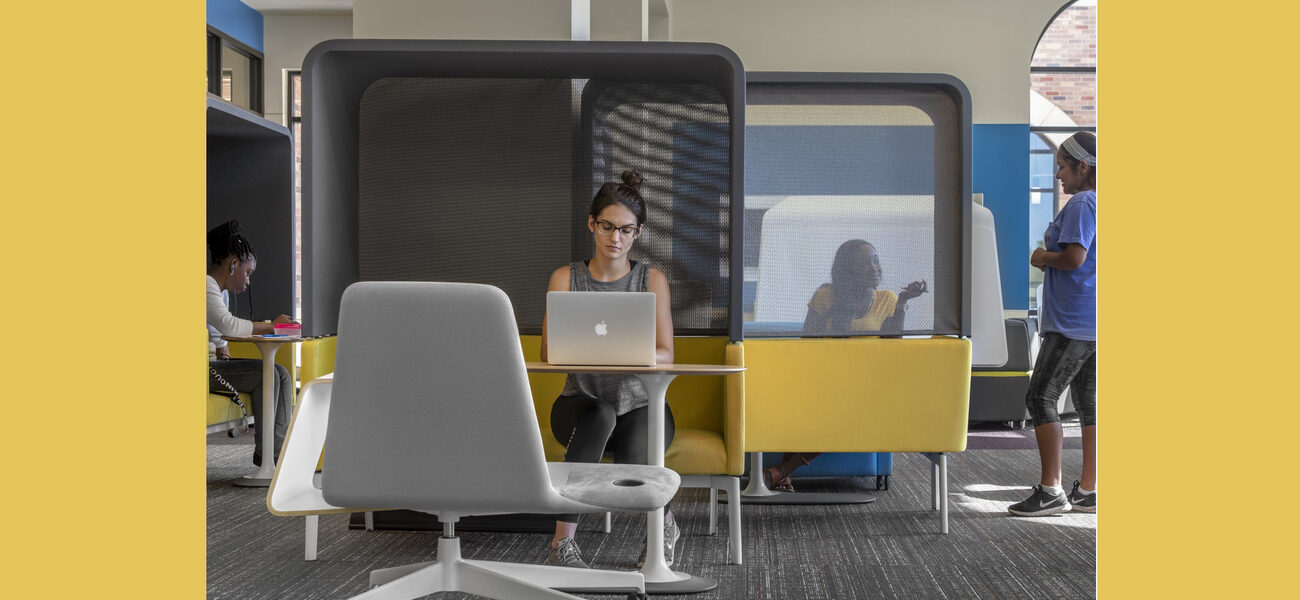Reflecting the pedagogical shift to student-led inquiry and collaborative learning, the Community Learning Center (CLC) is emerging as an important tool for student success. Results from in-depth studies at three Texas public universities with recently launched residence hall CLCs indicate that the new spaces have had a positive impact on student success, well-being, and retention.
Similar to a learning commons often found in the college library, the CLC, with its location inside the residence hall, takes a giant step to integrate the student living-and-learning experience and promote a healthy work-life balance for students. These technology-rich spaces with a variety of furniture, offer an array of settings to accommodate both individual and group study in open, semi-private, or private areas. The proximity and access to resources encourages students to more efficiently spend time studying, which allows for greater campus life activity.
The CLC is more than “a place to build knowledge and practice self-directed learning,” says Nadia Zhiri, Student Life studio leader and principal, TreanorHL Architects, which designed the Texas projects—Hullabaloo Hall at Texas A&M University (TAMU), Legacy Hall at Midwestern State University (MSU) and Piney Woods Hall at Sam Houston State University (SHSU). “It’s a student living experience designed to achieve personal, social, and academic success. Research shows that students living within living-learning facilities are making better grades and are staying in school longer.”
What’s in a CLC?
While all three residence halls have study rooms and community lounges on the sleeping floors, the CLCs provide more variety and flexibility of the furnishings in a space where students can study, with access to university technology and software resources, making them a unique and sought-after amenity in the convenience and security of their residence hall.
“The design of the CLC is based on the precept that students study in different ways,” says Zhiri. “We want to accommodate their study preferences, whether in a really cushy chair or sitting at a table. The more different settings, the better.”
“Student learning no longer exists in the vacuum of a classroom—it is happening through the entire campus experience,” observes Matthew Park, associate vice president and dean of students at MSU in Wichita Falls, Texas.
MSU included a 3,407-sf CLC in its newly constructed 500-bed Legacy Hall, which opened in fall 2016. The 75-seat CLC incorporates four different settings—private, semi-private, focused, and open—which support the spectrum from single to group study. It operates 24/7 and can be used by the entire student body of roughly 6,000.
SHSU, in Huntsville, built a 2,385-sf CLC space in its newest housing facility, the 700-bed Piney Woods Hall, which came online in 2017. Seating 60, the learning center offers semi-private, focused, and open settings, along with a staffed desk that provides free printing. Given SHSU’s much larger enrollment—roughly 20,000 students—the CLC is reserved only for Piney Woods residents. It is open 16 hours a day.
TAMU, in College Station, created the 2,776-sf Northside CLC within the 648-bed Hullabaloo Hall. The CLC seats 75, and offers private, semi-private, focused, and open settings, along with a staffed desk and resource library available approximately 16 hours a day. The facility is accessible 24/7 to all students of the Northside residential neighborhood (approximately 3,200 beds across all buildings out of a total enrollment of nearly 70,000 students). Wireless printing and school supplies are available at no to low cost for students using the CLC. The CLC is situated across the hallway from academic tutoring and support services and adjacent to amenity spaces serving as the “living room” for the Northside campus neighborhood.
Specific Configurations
Legacy Hall’s CLC is divided into three private, one semi-private, three focused, and two open areas. It also has a kiosk for fee-based printing and a librarian desk where student assistants are available in the evening to help with research.
Intended for group work, the glass-walled private rooms are tucked away in corners along the perimeter. Two rooms feature conference table seating, with six or eight chairs; the third has five comfortable tablet chairs with device connections. The semi-private space, nestled into a niche out of the main circulation path, is outfitted with lounge furniture and equipped with an LCD panel.
Each of the three, more centrally located focused areas sports a different configuration that supports individual work. Perpendicular to an interior wall are two rows of library-like study carrells with a total of 12 individual seats. Another grouping is a mix of several study pods—small, enclosed computer benches that can accommodate one or two people—and a round table partitioned into three sections and topped by a noise-mitigating fabric canopy. A similarly equipped partitioned table occupies the third focused space.
The centerpiece of the open space is a Steelcase media:scape, a collaborative setting that integrates furniture and technology in a single system. The couch-like seating is equipped with controls that allow students to project multiple laptop screens simultaneously onto a pair of wall-mounted LCD panels. There is also a small nook with lounge furniture where students can get together and work collaboratively.
The most unusual CLC feature is undoubtedly the sleeping pod, a tangible reminder of the connection between wellness and productivity. Designed for a restful time out or power nap, the pod reclines and plays soothing sounds like ocean waves or chirping birds over a 20-minute cycle. It even has a massage option.
“Sleep is critical to health,” says Park. “The intent is to provide a place for the student to let go and relax in the moment, then re-focus and return to work refreshed. This is very different from curling up on a couch or in an overstuffed chair.”
The smaller CLC, in SHSU’s Piney Woods Hall, has a similar array of settings, minus the private rooms. Its two semi-private spaces are furnished with a couch, coffee table, lounge chair, and ottoman. One of the two focused areas has a grouping of individual workstations; the other has two round partitioned tables. In the five different open areas are a media:scape, two groupings of lounge chairs and small tables, and two spaces with six-person round tables, two of which are adjacent in the middle of the room. Movable privacy screens can be arranged to segregate individual furniture clusters.
Slightly smaller than the CLC at Midwestern State, the Northside CLC at TAMU, features a similar array of settings. Two private rooms with conference table seating, three semi-private spaces with moveable lounge chairs and sofas, and a 16-station computer bank anchor the exterior walls. The circular staff desk is a primary visual feature in the middle of the room, located in front of two three-carrel partitioned tables, a single worktable, and a laptop bar with seating for four. In addition, at the front of the room between the two exits, several high-sided lounges and mobile laptop chairs offer more comfortable but focused spaces adjacent to the media:scape. Mobile marker boards offer writable surfaces in addition to acting as adjustable privacy screens. Wall mounted media screens and white boards are located at the front and rear of the room.
Commonalities and Contrasts
In addition to the media:scape and various types of comfortable furniture, all CLCs are equipped with moveable marker boards, flat-screen monitors, multiple technology ports and charging stations, security cameras, and card access. Organizationally, they are overseen by the campus Housing and Residence Life group in the Student Affairs Office.
The residence halls also have a faculty-in-residence program, a reinterpretation of the age-old English tutorial system. At MSU, the applicant selected for the two-year term is compensated with an unfurnished two-bedroom apartment, a meal plan, and a one-course buy-out. Program obligations include organizing on-site lectures and special events. While the position requires no CLC-specific duties, the presence of a professor (and family—the current occupant lives there with his wife and young son) in the building reinforces the sense of an academic community, creating opportunities for interaction with faculty beyond the classroom and helping to “humanize” the college experience, especially for entering students, according to Park.
Staffing is one of the main differences between the CLCs. SHSU and TAMU opted to have a desk inside the CLC with staff who oversee the resource library and printing and who are available to assist students throughout operating hours. On the other hand, the MSU space is staffed outside the CLC, in a 3,500-sf multi-purpose area with a catering kitchen, recreational game area, mailboxes, a convenience store, and access to an outdoor plaza.
“We have a 24-hour service desk right outside of the CLC door, so someone is available for students needing assistance, for example to report an equipment issue or check out markers,” says Park. “That person is also available to monitor other community spaces throughout the learning commons. We also have security cameras inside the CLC.”
The Research Results
To measure the CLCs’ performance and test the hypothesis about student success, the TreanorHL team collected quantitative and qualitative data from week-long observations; on-line surveys completed by residents; and paper surveys completed by CLC users. That data was supplemented with interviews with students; administrators; and custodial, maintenance, and IT staff. The intent of the study was to assess the CLC’s contribution to student success; its utilization; and which aspects of the design, programming, and operations were successful and which needed improvement.
In total, 145 interviews were conducted, and observations were made five to six times per day for seven days. The online survey revealed a CLC usage rate of more than 83 percent of Hullabaloo residents at TAMU, 85 percent among SHSU’s Piney Woods Hall residents, and 70 percent among those living in MSU’s Legacy Hall.
Both TAMU and SHSU students cited “printing” as the top reason they visited the CLC, not surprising with the provision of unlimited free printing at SHSU and low-cost wireless printing at TAMU. This was followed by “study alone.” Observation revealed that focused and private areas are constantly in use, highlighting the convenience of having these spaces and tech services on site, especially desirable after dark for safety concerns. At all three schools, access to the CLC as a safe study option was said to decrease anxiety and stress amongst users.
At MSU, which has more options for individual study, the most-reported reason for using the CLC was to study alone, followed by studying in a group. Park notes that non-residents are not admitted to the residential floors after 1 a.m., so the CLC is the only place where outside students can participate in a group project with building residents during the early morning hours.
As for the specific CLC components, the private group study rooms have the highest utilization rate at MSU and TAMU. The no-reservation policy often has students waiting at the door for the current occupants to leave, but it was observed that students at TAMU develop a pattern of rotating through the space types within the CLC, based on a changing need of use. The semi-private room, with lounge furniture, is used the least at MSU, a fact Park attributes to the student preference for working face to face instead of side by side. In the focused areas, the study carrells and computer benches are highly utilized by individual students. He adds that the sleeping pod does not get as much use as anticipated, theorizing that a more private location and a broader communication effort about its purpose could boost utilization.
Of MSU’s two open areas, the media:scape and adaptable lounge furniture are used roughly the same amount. While student groups typically range from three to eight, they can be as large as 20, so having those flexible open spaces is helpful, Zhiri points out. The lounge furniture, in particular, is readily adapted to create a semi-private space for individuals and small groups by tightly grouping the chairs together.
At SHSU, which has no private rooms, it is the two focused areas that are used the most, followed by the two semiprivate rooms. At TAMU, the private rooms are most highly used, followed by all of the types of semi-private and focused spaces, many with additional adaptations using marker boards as privacy screens.
Overall feedback on the design features indicates that students want more private study rooms. They also want more moveable white boards and more flexible tables to accommodate their devices and, at MSU, food. Free printing with greater options for color and scanning are in high demand. Students at SHSU and MSU requested more computers to give them access to high-quality software that they can’t afford for their laptops. There was also interest in library services so students could order books online and have them delivered to the CLC. These modifications and design tweaks, like vinyl rather than fabric upholstery to make the furniture easier to clean, can be implemented in the future.
Offering the only PC workstations available 24/7 on the entire campus, the MSU CLC’s round-the-clock schedule is a highly rated feature, not surprising given that about 54 percent of entering students are first generation, many of whom can ill afford their own computers.
MSU’s operational policy allowing food and drinks also gets high marks, especially among students who spend several hours at a time working in the CLC. The drawback is a negative impact on cleanliness and maintenance. SHSU and TAMU avoid these issues by allowing only bottled beverages with a screw cap and no food. Having a staffed desk ensures compliance, generating a higher level of student satisfaction with cleanliness and maintenance.
Confirming Student Success
The most important objective of the TreanorHL research was to determine what kind of impact the CLC and all its features had on student success. From the academic perspective, students at both institutions agreed that the centers enhance their learning experience, improve their study habits, motivate them to finish work, provide a good environment for group work, and support their success. “This is the magical finding,” says Zhiri.
Students also reported similar satisfaction levels when asked about the link between the CLC and their social success. They agreed the facility presents the opportunity to interact with others, mostly providing an opportunity to network with other students over coursework and activities. Findings also suggest that students are motivated to study by the social interactions provided in the CLC spaces. At the same time, Zhiri is quick to point out that social success does not equate to socialization, meaning that using the CLC to gather with friends is reported only rarely. Academic networking and studying alongside other students provide social opportunities based in the academic “job” of studying. For regular users in the CLCs, this creates an efficiency in their studying that allows more time for actual socialization elsewhere, on campus or off. This creates a better work-life balance for students, associating the time spent in the CLC as adding to overall well-being.
Another positive impact is on recruitment. Students mentioned in their interviews that they and their parents found features like the high-tech contemporary furniture, the media:scape, and the sleeping pod attractive during their campus tour.
The added value of the CLC translates into higher room rates for Legacy Hall. “We charge over $1,000 more for this residence hall compared to others on campus, and it is the first one to fill and the first to have a waitlist,” says Park. Also, retention rates from the fall to spring semester are 6 percent higher in the residence compared to the campus average. “I won’t say it is causal, but it is correlated, which is definitely a success point.”
Park continues that with the inclusion of a CLC, the residence hall has now become far more than a dormitory where students go to sleep. CLC users who reside in Legacy Hall reported higher satisfaction with their residence hall than non-CLC users who also reside in the building.
“We believe these amenities are a worthy investment,” he concludes.
By Nicole Zaro Stahl
